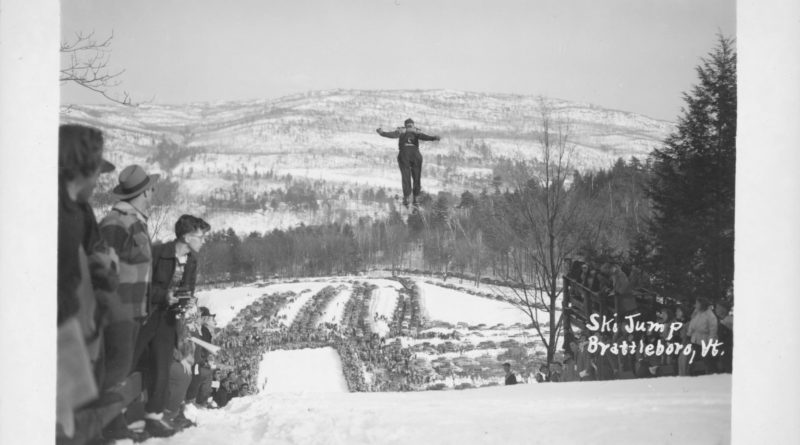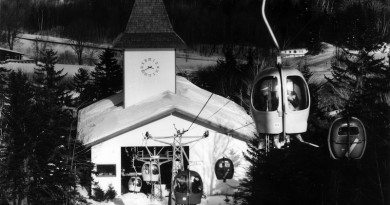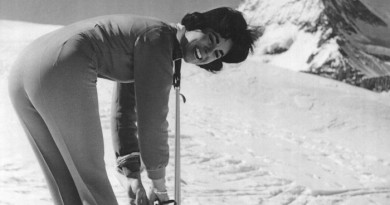100 Years of Flying
By Kevin O’Connor.
In the dizzyingly heady days of the early 1900s as the Wright brothers were pioneering the first airplanes, a 23-year-old from Brattleboro strapped wooden slats to his feet and catapulted off a snow-covered ramp.
“Broke all my skis to pieces,” Frederick Harris penned in his diary in the winter of 1910. Two more timbers brought two more tries.
“Fell twice,” he wrote.
But again, persistence.
“Tried jump several times, and at last made it,” Harris proclaimed. “Hurrah, twice. Oh! Ye! Gods!”
If only Harris could have foreseen what it would snowball into.
In 1922, when the Vermonter went on to build what’s now the Harris Hill Ski Jump in his hometown of Brattleboro, he needed only a few planks for a launchpad and two more to lash to his boots to leap off a peak 30 stories high at speeds of up to 60 miles per hour.
“The jump provided heroics for all to see,” winter sports historian E. John B. Allen wrote. “It really did seem that a man could fly.”
That jump – albeit rebuilt —still stands today: the only Olympic-sized ski jump in New England and one of a mere six of its height in the nation. It will celebrate its 100th year on Feb. 18-20 drawing a crowd of world-class athletes and several thousand spectators.
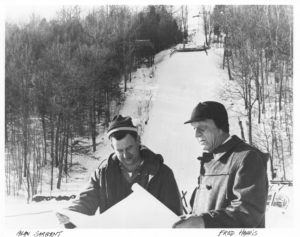
That’s just the latest wrinkle in the long history of Harris Hill rising above seemingly insurmountable odds.
The oldest known skis —discovered in the snowdrifts of Russia—date back some 10,000 years. But “skiing” and “ski jumping” were not household words when Harris, a sportsman turned stockbroker, introduced the sport to the northeastern U.S.
“When, as a young man, Harris first began skiing in the winter of 1903-04, only a few Americans had ever strapped on skis for sport or simply to travel,” Allen writes (albeit failing to acknowledge early native Americans who may have used skis for hunting or to traverse).
A pioneering “extreme skier,” Harris was one of the founders of the Dartmouth Outing Club. The first such organization of its kind, its mission was “to stimulate interest in out-of-door winter sports,” he wrote in the college newspaper. In 1913, Harris —along with DOC members Carl Shumway and Joseph Cheney — became the first men credited with hiking and skiing Mt. Washington. Harris also claimed the first ski descent of Whiteface, in the Adirondacks.
Harris lived for adventure. He often canoed the Connecticut River to commute between Dartmouth College and his home in Brattleboro, 70 miles south. In 1912, Harris won the U.S. mixed doubles tennis championship and in 1920 he piloted his 87-year-old grandmother in a plane.
That’s why locals weren’t surprised when Harris, who shaped boards and shellacked them to make his own skis—created the Brattleboro Outing Club in 1922, the same year he created his namesake jump.
Harris had eyed an evergreen-covered hill on Cedar Street in December of 1921. In a month, workers cut trees, blasted rocks, smoothed the slope and constructed 350 steps up to a wood trestle jump— at a cost of $2,200.
Harris then enlisted his sister, Evelyn, to help him test the hill. Though Evelyn Harris and, later, the sisters Dorothy and Maxine Graves, were skiing off the jump before World War II, it wasn’t until 2014 that women were allowed to ski jump at the Olympics.

The first event on Harris’ ‘hill’ was held Feb. 4, 1922. It was billed as that year’s state championship and drew a crowd of 2,500. Charles Edward Crane, writing in his book Winter in Vermont, explained the new sport:
“A speck of something black is seen gathering motion at the top of the trestle. It soon appears to be the Lilliputian figure of a man. It comes forward with express-train speed and assumes life size as he shoots from the take-off and stands in midair for a split second, and then resumes contact with the planet by landing on the slanting base of the hill.”
Crane was an Associated Press correspondent who had witnessed his share of history on both sides of the Atlantic. But he recalled the ski jump’s beginning with a particular fondness.
“I think I shall never see more interesting ski events than in those days when jumping was so new, and the crowd at Brattleboro more picturesque in a hit-or-miss manner of dress than it is now in ski-tog smartness,” he wrote. “I remember vividly the figure of Beatty Balestier, the troublesome brother-in-law of Rudyard Kipling, who always drove into the ski meet in an old-fashioned pung [a low-slung horse-drawn sleigh] filled with straw and buffalo robes—and apparently quite a bit of liquid warmth for the inner man.”
For its part, The Brattleboro Reformer summed up spectators’ reactions in 1922: “They surely got their money’s worth of spectacular ski jumping.”
Harris, who enlisted his college geology professor to judge the meet, leapt 107 feet.
“Harris came in for a good share of the applause,” the Reformer reported. “The onlookers, especially the Brattleboro residents, knew that but for him the ski jump project never would have come about.”
The press reported one injury: a 17-year-old from New Hampshire who strained a muscle. But rather than deter people, “the voyeuristic pleasure of watching danger and play at the same time helped bring the crowds in,” Allen notes.
The hill would host its first national championship in 1924, deemed by then-governor Redfield Proctor Jr. as “the most thrilling entertainment I ever saw…not only a splendid advertisement for Vermont as a winter sports region but a tremendous incentive to the development of ski sport throughout the East.”
Harris Hill would go on to host multiple National Championships and produce champions such as local hero, Brattleboro’s Merrill “Mezzy” Barber and Norwegian-born ski jumping legend, Torger Tokle, who won the event three times. Tokle was the first to win the Winged Ski Trophy, a trophy Harris had commissioned jeweler Cartier to create. Both Tokle and Barber served in the burgeoning 10th Mountain Division where Tokle lost his life fighting in the battle of Riva Ridge in Italy.
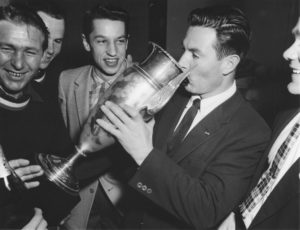
World War II brought a hiatus to the competition. Lack of snow had also caused the event to be canceled several times before the war. But competition at the Harris Hill Ski jump came back in 1946 with famed travel writer Lowell Thomas broadcasting the NBC nightly radio news live from the event’s annual dinner in Brattleboro’s Brook’s House.
While the Harris Hill annual competition has attracted ski jumpers from around the world (with Norway’s Arthur Tokle, Ukraine’s Vladimir Glyvka and Slovenia’s Blaz Pavlic all winning three times or more), it also created some hometown heroes.
Putney’s John Caldwell, author of the seminal book on cross-country skiing, started out as a Nordic Combined athlete and represented the U.S. at the Olympic Games in 1952. Brattleboro native Dana Zelenakas began jumping at age 7 and went to the 1972 Olympics in Japan. Another Brattleboro skier, Jim Galanes, would represent the U.S. at three Olympics in Nordic Combined, from 1976 to 1984. In 1972, a red-headed freshman from Middlebury College named Hugh Barber won the event in front of a crowd of 4,000. Barber (Mezzy Barber’s nephew), grew up in Brattleboro. He would go on to win again the next two years, also retiring the Winged Ski trophy.
By the early 1980s, time and weather caught up with the hill. Winters were less predictable and in 1985 Harris Hill added 2,000 feet of snowmaking pipe so it could host the 1992 National Championships, a qualifier for the Olympics. Liability insurance kicked in and helmets, which hadn’t existed in the early days of the event, became prevalent.
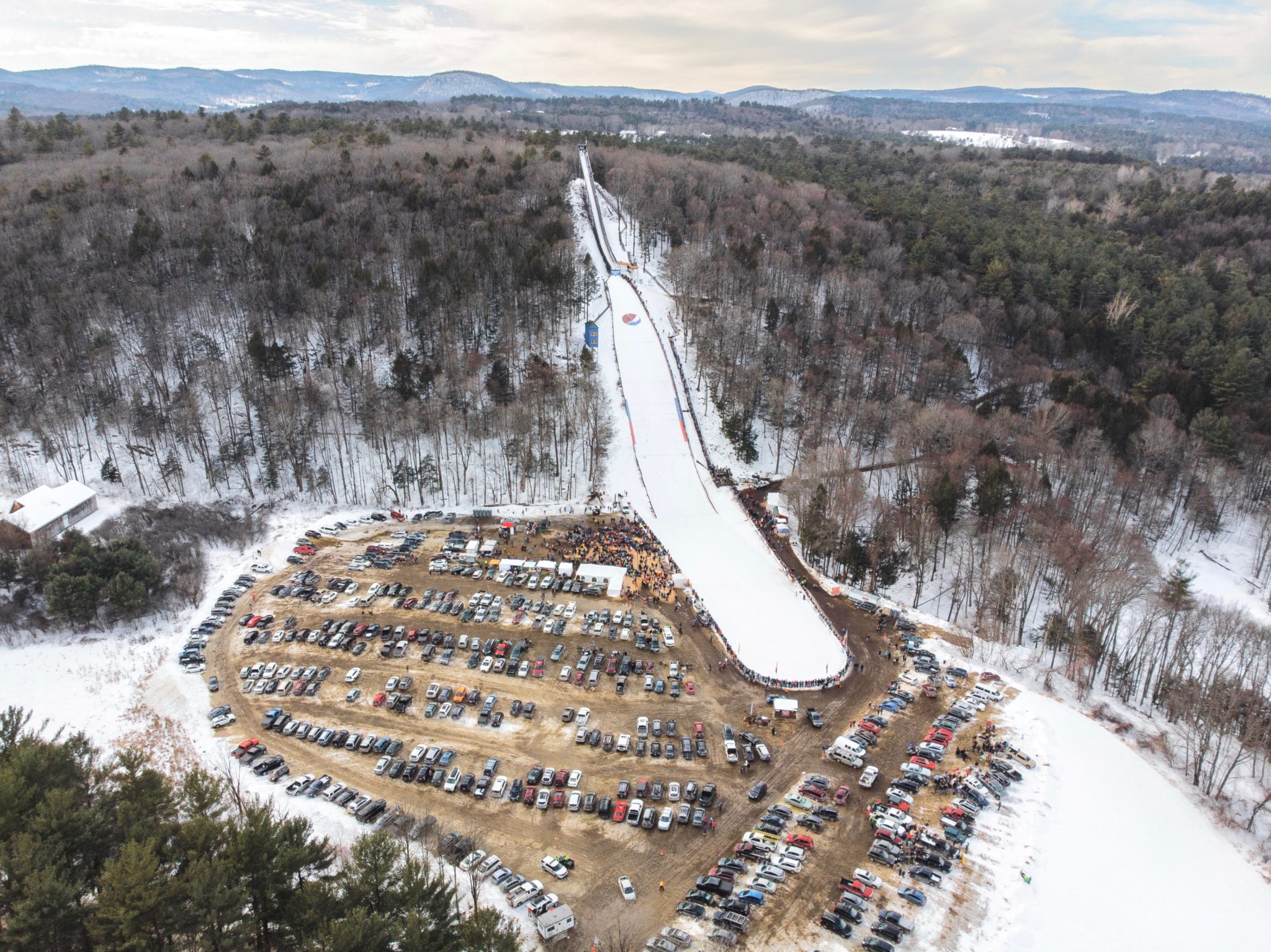 In 2003, the local Rotary Club put up $20,000 for a new spectator stand. But it would not get much use right away: in 2005, the U.S. Ski and Snowboard Association deemed Harris Hill’s starting tower unsafe. Events were canceled as the organizing committee struggled to come up with the $1 million it would cost to rebuild it.
In 2003, the local Rotary Club put up $20,000 for a new spectator stand. But it would not get much use right away: in 2005, the U.S. Ski and Snowboard Association deemed Harris Hill’s starting tower unsafe. Events were canceled as the organizing committee struggled to come up with the $1 million it would cost to rebuild it.
When the Associated Press wrote that Harris Hill was in jeopardy, donations began pouring in with one wealthy donor writing a check for $130,000 and by 2009, after a three-year hiatus, the hill was rebuilt and the annual competitions were back on.
The new 90-meter jump with its steel take-off ramp was higher and faster than its predecessor and the record books had to be retired. Chris Lamb, a New Hampshire native who graduated from nearby Marlboro College, took home top honors in 2010 and 2013. Lamb set a record with a 102-meter jump in 2010, a record Slovenian Blaz Pavlic would break in 2017 by landing at 104 meters.
In 2020, the last running of the event before Covid, Lamb faced off with another two-time winner, Pavlic. In the end Pavlic outjumped Lamb by 5.5 meters, to earn the Winged Ski Trophy. Lamb retired from ski jumping and moved out west. But he will be back for the 2022 event.
“I grew up jumping at Harris Hill (first jumps at age 11) and have always loved the atmosphere in Brattleboro. I was at Marlboro College from 2014-2018 and it was such a special thing to be able to drive down the hill and step back into the ski jumping world for a weekend each year,” he says. “Though the Winged Trophy has been retired, and I live quite far away, I’m still drawn back to Harris Hill because of the community and the wonderful memories I have there,” he says.
This year, more memories will be made.
Excerpted from “Harris Hill Ski Jump: The First 100 Years,” by Kevin O’Connor. Available at harrishillskijump.com.
How to Watch the Harris Hill Jump
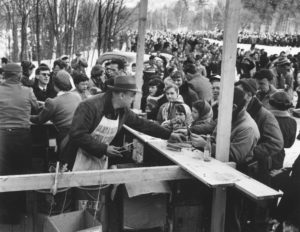 Brattleboro’s Harris Hill Ski Jump celebrates its centennial Feb. 18-20. The weekend kicks off with fireworks, food, and beverages on Friday night. More than 40 of the world’s top ski jumpers compete on Saturday for the Pepsi Challenge and U.S. Cup, with the Fred Harris Memorial Tournament on Sunday. The competitions begin at 10 a.m. both days. The annual event is held on the rebuilt jump, a 90-meter Normal Hill (as jumps of that size are designated by Olympic standards) and the competitions are sanctioned by the United States Ski Association (USSA). Jumpers start with 20 style points given. Judges look not just at the distance but at takeoff, flight and landing and deduct points for faults. High and low scores from the judges are eliminated to get the final score for each jump. Dress warmly and watch a part of ski history come back to life. harrishillskijump.com. —L.L.
Brattleboro’s Harris Hill Ski Jump celebrates its centennial Feb. 18-20. The weekend kicks off with fireworks, food, and beverages on Friday night. More than 40 of the world’s top ski jumpers compete on Saturday for the Pepsi Challenge and U.S. Cup, with the Fred Harris Memorial Tournament on Sunday. The competitions begin at 10 a.m. both days. The annual event is held on the rebuilt jump, a 90-meter Normal Hill (as jumps of that size are designated by Olympic standards) and the competitions are sanctioned by the United States Ski Association (USSA). Jumpers start with 20 style points given. Judges look not just at the distance but at takeoff, flight and landing and deduct points for faults. High and low scores from the judges are eliminated to get the final score for each jump. Dress warmly and watch a part of ski history come back to life. harrishillskijump.com. —L.L.
How to Get into Ski Jumping
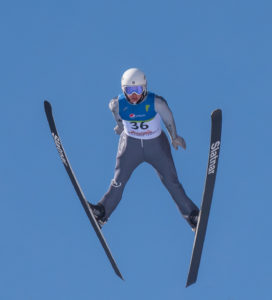
While it’s not hard to head to a terrain park where anyone can send it, finding a bona fide ski jump where you can learn the techniques to hold a crouch down the in run, soar off into the air, and land, one leg first, telemark-style, isn’t as easy.
In the 1920s, even before there were ski lifts, ski jumps began popping up around Vermont. In 1921, Stowe had a 25-meter ski jump on Marshall Hill (now a popular sledding hill) that drew a crowd of 2,000 to watch competitions during the town’s Winter Carnival. In 1924, two years after Fred Harris created Harris Hill, a 40-meter jump went up on Chipman Hill, on the outskirts of Middlebury. It was later replaced by a 50-meter jump at the Middlebury College Snow Bowl, which hosted the NCAAs for ski jumping in 1961 and 1973. The Lyndonville Outing Club had a 45-meter jump that operated from 1947 to 1972.
The hotbed in Vermont, however, was down south. In 1925, Vermont Academy put in the first of several small jumps on its Saxton’s River campus and the school became a training ground for ski jumpers. Not to be outdone, in 1936, the Putney School where John Caldwell taught erected a small 36-meter jump. In Dummerston, Maple Valley built a 45-meter jump in 1968.
Harris Hill’s large ski jump was for trained athletes, but founder Fred Harris helped erect a smaller, 25-meter one in Brattleboro’s Latchis Park that operated from 1952 to 1979.
By the 1970s, with the rising costs of insurance and waning interest in ski jumping, most of Vermont’s jumping hills had been decommissioned and destroyed.
However, in Brattleboro’s Living Memorial Park, new ski jumps were built in 2000 at the town’s recreation area, and there a new generation of ski jumpers is now earning to fly. Kids enrolled in the Harris Hill Junior Jumping Program practice twice weekly on the 10-meter and 18-meter jumps that were erected there in the early 2000s.
At Storrs Hill, just across the Vermont border from White River Junction, the Lebanon Outing Club offers coached practices for experienced skiers on Tuesday and Thursday evenings, from Jan. 11-Feb. 24. A season-long program costs $160 and the program has produced such athletes as Tara Geraghty-Moats, the 2020 World Cup champion in Nordic combined. Several other New Hampshire ski jumping programs are run by Ford Sayre, Mt. Washington and Nansen Ski Clubs.
In Lake Placid, the state-sponsored New York Ski Education Foundation teaches children as young as 7 on its smaller jumps (K20 and K48) and in 2020 finished North America’s first refrigerated track for its 90-meter and 120-meter jumps. There, the members of the U.S. ski jumping and Nordic combined national teams train year-round.
For more information visit the New England Ski Jumping Nordic Combined website at nesjnc.com. —L.L.
n

